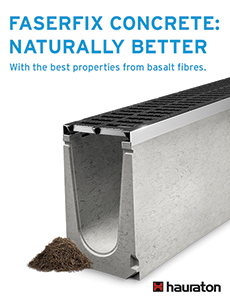Hauraton makes concrete material even more efficient for modern drainage technology by enhancing the formulation with natural basalt fibres.
The addition of mineral or textile fibres increases maximum stability, strength, and impact resistance. By amplifying the impact resistance, the more robust and durable the product. This is particularly important for components that are exposed to considerable dynamic stresses, in this case, drainage channels subject to vehicles at high speeds or regularly trafficked by heavy loads.
Basalt Fibres: Natural and Sustainable
Hauraton’s new era in concrete production by utilising basalt fibres has not only created a durable building material, but also one that is 100 percent natural. The basis of basalt rock is available all over the world in large quantities which is formed naturally on the earth’s surface. By combining basalt fibres with the well-known material concrete, both the structure and the service life of the product is increased.
Mineral Mixture: Easy to Recycle
Since the end product is a purely mineral mixture, there is no need for material separation during disposal. This protects the environment as it is simply fully-recyclable at the end of the product’s life cycle.
Convincing Strong Properties
Basalt fibres have outstanding properties. They can withstand temperatures of up to 800°C and are highly resistant to alkalis, acids, salts, oxidation and radiation. The effects of adding basalt fibres to precast concrete elements gives even more of a dimensionally stable, resistant and durable structure. Drainage systems made of basalt-reinforced concrete will assure longer performance.
Basalt Fibres are Versatile and Climate-Friendly
Basalt fibres are mineral fibres that have a higher melting temperature, better resistance to water, acids and alkalis, and more positive flexural strength. All this makes basalt fibres attractive in drainage technology, but also numerous other applications in construction.
Given the stricter climate targets, the energy consumption during production also clearly speaks in favour of basalt fibres, as basalt it has the lowest CO2 footprint.

